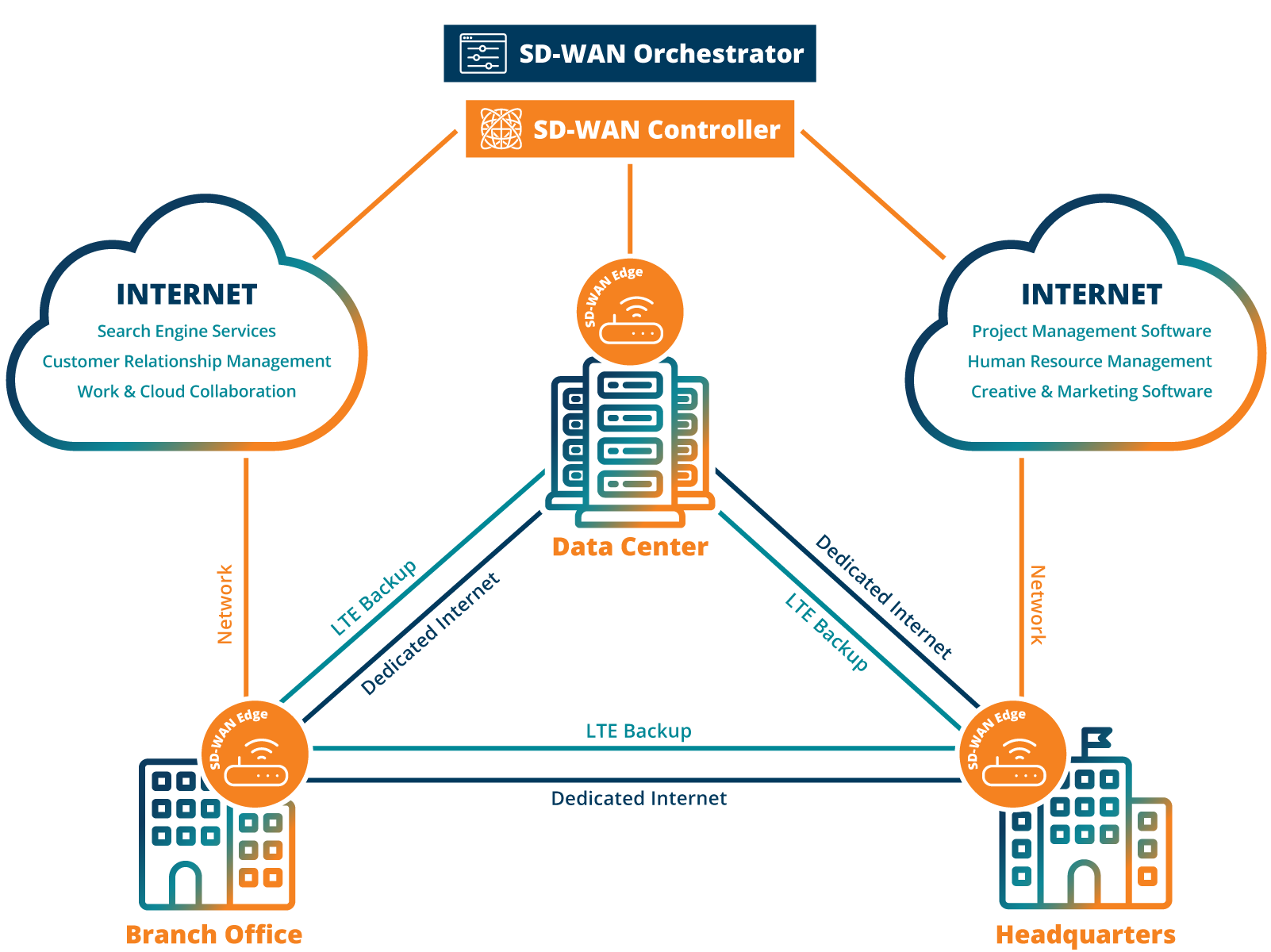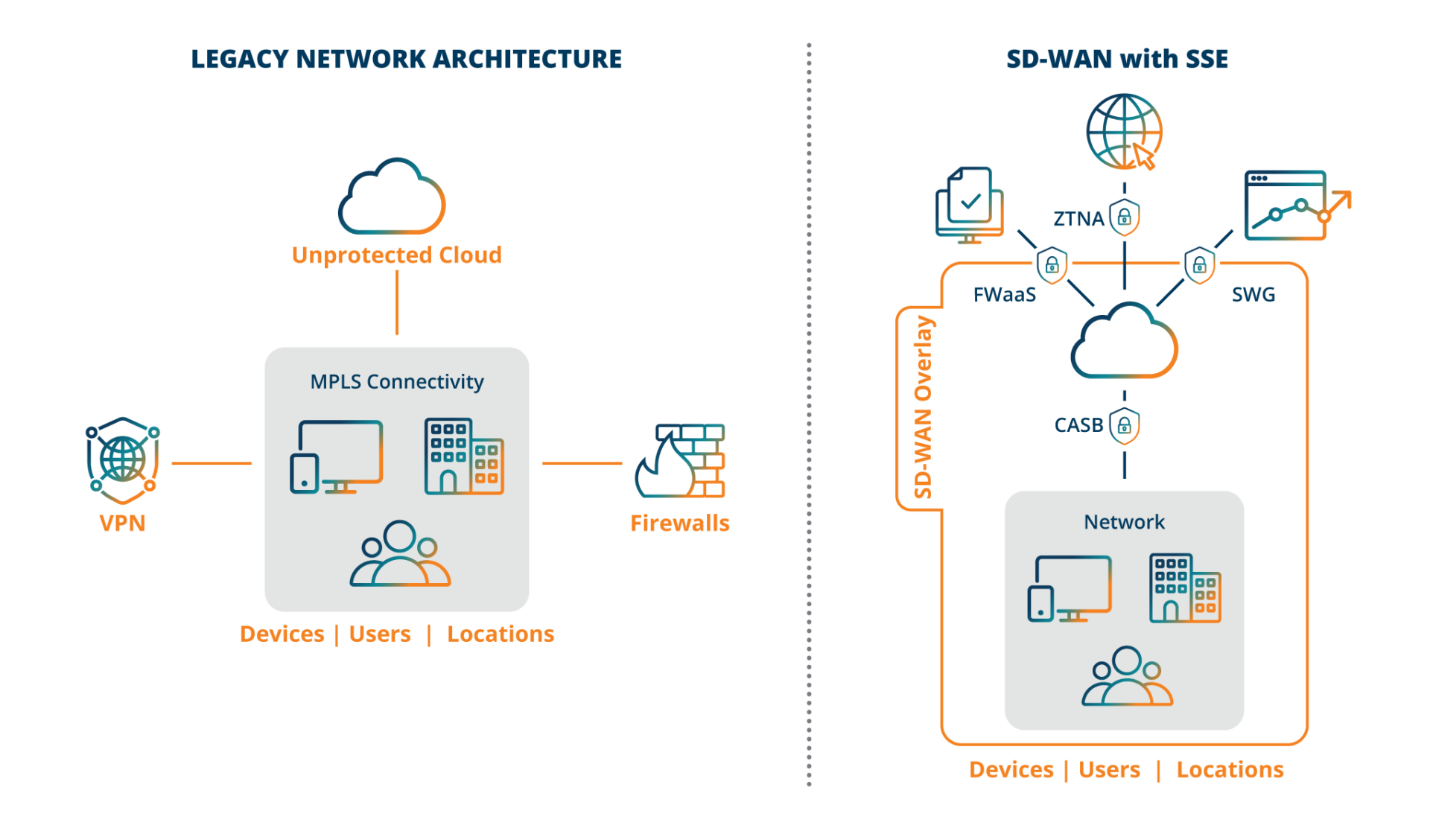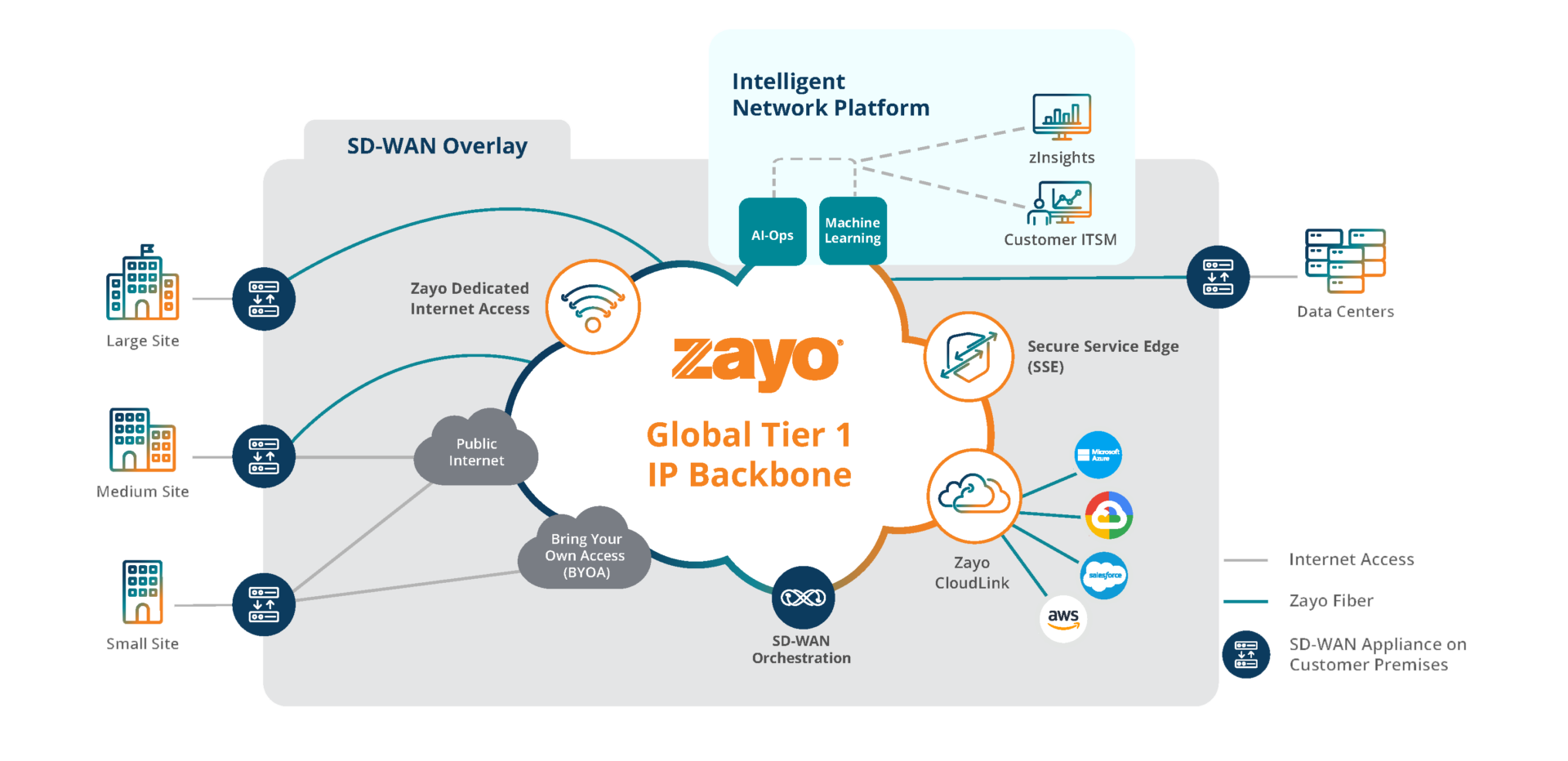Since its introduction to the market around ten years ago, software-defined wide area networks – or SD-WAN for short – have been redefining how enterprises manage networks. IT and networking teams use SD-WAN to enhance network performance, boost network reliability, and simplify network management and security.
This blog will guide you through what SD-WAN is, its architecture, benefits, and real-world applications.
What is a Software-Defined Wide Area Network? SD-WAN Definition
A Software-Defined Wide Area Network (SD-WAN) is a virtual wide area network (WAN) architecture that allows companies to leverage any combination of transport services—including MPLS, LTE, and broadband Internet services—to securely connect users to applications.
In contrast to its predecessors – like MPLS, broadband, and WANs – which employ hardware-based networking to improve network reach and reliability, SD-WAN uses software-based technology to create a smarter, more flexible network equipped for the digital age. These legacy networking solutions are typically not efficient enough for modern requirements, necessitating a switch to SD-WAN.
How Does SD-WAN Work? SD-WAN Explained
SD-WAN simplifies WAN management and operation by separating the networking hardware from its control system.
Traditional WANs like MPLS, by comparison, used more decentralized approaches to network management and control. This often meant IT teams had to individually manage each network device at each branch location, manually applying network configurations and policies at each. This process was time-consuming, especially for those managing large, multi-site networks.
SD-WAN’s software-based approach allows users to centralize network management and increase network flexibility, spending less time on manual management and configurations, letting the technology do the work for you.
SD-WAN Architecture
SD-WAN uses a centralized control function to securely and intelligently direct traffic across the WAN. SD-WAN doesn’t require one physical link to transmit data, it will intelligently choose the best option from a variety of open paths. This improves application performance, enhances user experience, and increases business productivity. The architecture consists of:
- Edge Devices: These are deployed at each location and connect to the central controller.
- SD-WAN Controller: It manages the policies and the traffic routing across the network.
- WAN Transport: Various transport methods on top of legacy solutions like MPLS, broadband, and secondary backup routing on LTE are used.

How SD-WAN Enhances WAN
Traditional WANs often rely on MPLS circuits, which can be costly and complex to manage. Traffic routing in traditional WANs typically follows pre-determined paths based on router configuration. Teams need to intervene manually to reroute traffic when network conditions change, for example, in the case of network congestion or an outage.
SD-WAN, on the other hand, allows for dynamic path selection, which means it can route traffic over the best-performing paths in real time. This ensures optimal performance and reliability.
SD-WAN Providers
The market is brimming with vendors offering SD-WAN solutions. You must puzzle together a holistic edge solution, including SD-WAN, that works for your unique business needs. The tools and vendor hardware that work for one business are likely not the same that will work perfectly for another.
That said, here are a few notable vendors that Zayo works with to come up with effective SD-WAN solutions for our customers:
- Fortinet SD-WAN: Known for its security features integrated with SD-WAN.
- Palo Alto SD-WAN: Offers robust security with its firewall integration.
- Versa SD-WAN: Provides comprehensive security, analytics, and multi-cloud support.
- VeloCloud: A leader in SD-WAN solutions with strong cloud capabilities.
- Cisco Meraki SD-WAN: A simple, user-friendly cloud-based SD-WAN solution with easy scalability across multiple sites.
MPLS vs. SD-WAN
Multi-Protocol Label Switching (MPLS) has been the traditional approach to enterprise networking. However, SD-WAN offers several advantages over MPLS:
- Cost: SD-WAN can reduce costs by using cheaper broadband connections instead of more expensive MPLS circuits.
- Time: SD-WAN reduces time spent on manual network configuration, management, traffic routing, and monitoring with a centralized control plane.
- Flexibility: SD-WAN can use multiple types of connections, including MPLS, broadband, and LTE.
- Performance: SD-WAN improves application performance by dynamically routing traffic based on current network conditions.

Why Move from MPLS to SD-WAN?
Many enterprises are transitioning from MPLS to SD-WAN to leverage these benefits. According to Gartner, by 2026, over 70% of enterprises will have implemented SD-WAN to enhance their network capabilities.
SASE vs. SD-WAN
Secure access service edge (SASE) combines network security functions with WAN capabilities to support the growing security needs of organizations. SASE layers on top of SD-WAN infrastructure to simplify and integrate your network security.
While SD-WAN focuses on optimizing network performance, SASE integrates security features such as Zero Trust, Firewall as a Service (FWaaS), and Secure Web Gateway (SWG) into the network. Together, these solutions enable efficient, secure, and performant networks.
How SASE and SD-WAN Work Together
Together, these solutions are more powerful than they are alone. Here’s what they enable when combined:
- Enhanced Security: SASE adds a layer of security to SD-WAN, creating a comprehensive network and security solution.
- Unified Management: Enterprises can manage both network and security policies from a single platform with certain managed service providers (including Zayo.)
- Improved Performance: The combination ensures that security does not compromise network performance.
SD-WAN Use Cases
SD-WAN’s versatility makes it suitable for various industries. Here are a few real-life examples of Zayo customers using SD-WAN to improve their networks:
SD-WAN in Healthcare
Healthcare providers can use SD-WAN to ensure secure and reliable connectivity for telemedicine applications. This improves patient care by providing real-time access to medical records and remote consultations.
One of Zayo’s healthcare customers, a national dental practice, came to Zayo with a hybrid MPLS and Internet solution in place at the majority of their sites. This system was costly and complex, so Zayo came up with a simpler solution to replace it. By replacing the majority of their stack with a VMWare VeloCloud SD-WAN solution, Zayo gave the customer space to operate bandwidth-intensive applications at peak performance and streamlined their network edge. Zayo also helped the customer reduce costs, improve reliability, and integrate their data centers into their new network solution. Overall, the SD-WAN solution made the dental organization’s network more management, stable, and performant.
SD-WAN in Finance
Financial institutions can leverage SD-WAN to enhance network security and performance across multiple branches. This ensures secure transactions and real-time data access, which are critical for banking operations.
A large financial insurance firm came to Zayo for help with a unique challenge. They needed to connect 6,000 dispersed office and agent locations across the enterprise. They decided to manage the solution in-house but needed help configuring the SD-WAN solution and deploying it at scale. Zayo handled asset tagging, configuration, process integration, and shipping of the customer’s VeloCloud SD-WAN solution. In total, Zayo configured and shipped more than 18,000 devices. Zayo also ensured configuration in the customer’s multiple data centers and security protocol implementation.
SD-WAN in Retail
Retail businesses can use SD-WAN to manage connectivity across multiple locations. This improves the customer experience by ensuring reliable payment processing and inventory management.
Faced with time and budget constraints, a running shoe retailer brought Zayo in amid divestiture from its parent company. They needed to connect 70 locations with a well-performing network fast. Using broadband connections with an SD-WAN software management overlay, they connected their locations with a stable, reliable solution with minimal risk. As a result, the customer opened the doors to all 70 locations in under 60 days, meeting the timeline of the divestiture, improving network stability, and saving time, resources, and money.
SD-WAN by Zayo

Zayo’s Managed Edge Services empower network agility with a vendor agnostic approach to our SD-WAN solutions, allowing businesses to move past legacy network limitations and remain focused on what’s next.
With Zayo’s industry-leading Managed SD-WAN, ranked #7 on Vertical System Group’s Carrier Managed Services leaderboard, you can connect all network devices and cloud locations on a tier-1 network and experience enhanced network performance and reliability.
Here’s what sets Zayo’s SD-WAN apart:
- Performance: Take the complexity out of your network operations with real-time traffic prioritization and AI automation. Immediately see improvements in network operations with real-time analytics which show you pertinent network traffic metrics, how traffic is prioritized, and the health of all of your network devices
- Management Options: Receive the level of management you want from Zayo – we can fully configure, manage, and monitor the solution, leave the management up to you, or co-manage the solution with you
- Customization: Zayo partners with industry-leading SD-WAN partners and customizes solutions to modernize, simplify, and enhance your network operations with a best of breed solution
- Security: Integrated security features protect your network from threats and vulnerabilities. Plus, Managed SASE from Zayo unifies security and enables an exception end-user experience
- Scalability: Unlike legacy network solutions, Zayo’s SD-WAN solution scales effortlessly so you can meet rapidly evolving business needs
- Monitoring: Access an intelligently built network observability portal, zInsights, built on our Intelligent Network Platform to see the performance and health of your entire network in real time
Simplify Your Network and Improve Network Performance Today
SD-WAN offers improved performance, flexibility, and security, making it an ideal solution for businesses looking to future-proof their networks. By understanding and implementing SD-WAN, IT professionals and network administrators can drive efficiency and innovation within their organizations.
